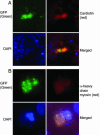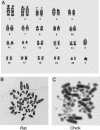Rat adult stem cells (marrow stromal cells) engraft and differentiate in chick embryos without evidence of cell fusion
- PMID: 15197249
- PMCID: PMC438968
- DOI: 10.1073/pnas.0401558101
Rat adult stem cells (marrow stromal cells) engraft and differentiate in chick embryos without evidence of cell fusion
Abstract
Cell fusion was recently reported to account for the plasticity of adult stem cells in vivo. Adult stem cells, referred to as mesenchymal stem cells or marrow stromal cells, from rat marrow, were infused into 1.5- to 2-day-old chick embryos. After 4 days, the rat cells had expanded 1.3- to 33-fold in one-third of surviving embryos. The cells engrafted into many tissues, and no multinuclear cells were detected. The most common site of engraftment was the heart, apparently because the cells were infused just above the dorsal aorta. Some of the cells in the heart expressed cardiotin, and alpha-heavy-chain myosin. GFP(+) cells reisolated from the embryos had a rat karyotype. Therefore, the cells engrafted and partially differentiated without evidence of cell fusion.
Figures






References
Publication types
MeSH terms
Substances
Grants and funding
LinkOut - more resources
Full Text Sources
Other Literature Sources
Medical

